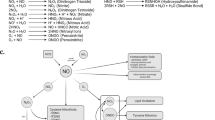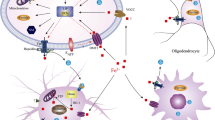Abstract
Within the central nervous system, tetrahydrobiopterin (BH4) is an essential cofactor for dopamine and serotonin synthesis. In addition, BH4 is now established to be an essential cofactor for all isoforms of nitric oxide synthase (NOS). Inborn errors of metabolism affecting BH4 availability are well documented and the clinical presentation can be attributed to a paucity of dopamine, serotonin, and nitric oxide (NO) generation. In this article, we have focussed upon the sensitivity of BH4 to oxidative catabolism and the observation that when BH4 is limiting some cellular sources of NOS may generate superoxide whilst other BH4 saturated NOS enzymes may be generating NO. Such a scenario could favor peroxynitrite generation. If peroxynitrite is not scavenged, e.g., by antioxidants such as reduced glutathione, irreversible damage to critical cellular enzymes could ensue. Such targets include components of the mitochondrial electron transport chain, alpha ketoglutarate dehydrogenase and possibly pyruvate dehydrogenase. Such a cascade of events is hypothesized, in this article, to occur in neurodegerative conditions such as Parkinson’s and Alzheimer’s disease.





Similar content being viewed by others
References
Kaufman S (1997) Tetrahydrobiopterin. basic biochemistry and role in human disease. John Hopkins University Press, Baltimore and London
Maita N, Hatakeyama K, Okada K, Hakoshima T (2004) Structural basis of biopterin induced inhibition of GTP cyclohydrolase I by GFRP, its feedback regulatory protein. J Biol Chem 279(49):51534–51540
Gross SS, Levi R (1992) Tetrahydrobiopterin synthesis. an absolute requirement for cytokine-induced nitric oxide generation by vascular smooth muscle. J Biol Chem 267(36):25722–25729
Heales SJ, Lam AA, Duncan AJ, Land JM (2004) Neurodegeneration or neuroprotection: the pivotal role of astrocytes. Neurochem Res 29(3):513–519
Werner ER, Gorren AC, Heller R, Werner-Felmayer G, Mayer B (2003) Tetrahydrobiopterin and nitric oxide: mechanistic and pharmacological aspects. Exp Biol Med 228(11):1291–1302
Brand MP, Heales SJ, Land JM, Clark JB (1995) Tetrahydrobiopterin deficiency and brain nitric oxide synthase in the hph1 mouse. J Inherit Metab Dis 18(1):33–39
Heales SJ, Canevari L, Brand MP, Clark JB, Land JM, Hyland K (1999) Cerebrospinal fluid nitrite plus nitrate correlates with tetrahydrobiopterin concentration. J Inherit Metab Dis 22(3):221–223
Zorzi G, Thony B, Blau N (2002) Reduced nitric oxide metabolites in CSF of patients with tetrahydrobiopterin deficiency. J Neurochem 80(2):362–364
Heales SJ, Blair JA, Meinschad C, Ziegler I (1988) Inhibition of monocyte luminol-dependent chemiluminescence by tetrahydrobiopterin, and the free radical oxidation of tetrahydrobiopterin, dihydrobiopterin and dihydroneopterin. Cell Biochem Funct 6(3):191–195
Gramsbergen JB, Sandberg M, Moller Dall A, Kornblit B, Zimmer J (2002) Glutathione depletion in nigrostriatal slice cultures: GABA loss, dopamine resistance and protection by the tetrahydrobiopterin precursor sepiapterin. Brain Res 935(1–2):47–58
Lovenberg W, Levine RA, Robinson DS, Ebert M, Williams AC, Calne DB (1979) Hydroxylase cofactor activity in cerebrospinal fluid of normal subjects and patients with Parkinson’s disease. Science 204(4393):624–626
Williams AC, Levine RA, Chase TN, Lovenberg W, Calne DB (1980) CFS hydroxylase cofactor levels in some neurological diseases. J Neurol Neurosurg Psychiatr 43(8):735–738
Barford PA, Blair JA, Eggar C, Hamon C, Morar C, Whitburn SB (1984) Tetrahydrobiopterin metabolism in the temporal lobe of patients dying with senile dementia of Alzheimer type. J Neurol Neurosurg Psychiatr 47(7):736–738
Sawada M, Hirata Y, Arai H, Iizuka R, Nagatsu T (1987) Tyrosine hydroxylase, tryptophan hydroxylase, biopterin, and neopterin in the brains of normal controls and patients with senile dementia of Alzheimer type. J Neurochem 48(3):760–764
Hunot S, Boissiere F, Faucheux B, Brugg B, Mouatt-Prigent A, Agid Y, Hirsch EC (1996) Nitric oxide synthase and neuronal vulnerability in Parkinson’s disease. Neuroscience 72(2):355–363
Good PF, Hsu A, Werner P, Perl DP, Olanow CW (1998) Protein nitration in Parkinson’s disease. J Neuropathol Exp Neurol 57(4):338–342
Qureshi GA, Baig S, Bednar I, Sodersten P, Forsberg G, Siden A (1995) Increased cerebrospinal fluid concentration of nitrite in Parkinson’s disease. Neuroreport 6(12):1642–1644
Jenner P, Dexter DT, Sian J, Schapira AH, Marsden CD (1992) Oxidative stress as a cause of nigral cell death in Parkinson’s disease and incidental Lewy body disease. the Royal Kings and Queens Parkinson’s disease research group. Ann Neurol 32(Suppl):S82–S87 (review)
Blair JA, Pearson AJ (1974) Kinetics and mechanisms of the autoxidation of the 2-amin-4-hydroxy-5,6,7,8-tetrahydropterins. J Chem Soc Perkin Trans II 80–88
Smith MA, Richey Harris PL, Sayre LM, Beckman JS, Perry G (1997) Widespread peroxynitrite-mediated damage in Alzheimer’s disease. J Neurosci 17(8):2653–2657
Vodovotz Y, Lucia MS, Flanders KC, Chesler L, Xie QW, Smith TW, Weidner J, Mumford R, Webber R, Nathan C, Roberts AB, Lippa CF, Sporn MB (1996) Inducible nitric oxide synthase in tangle-bearing neurons of patients with Alzheimer’s disease. J Exp Med 184(4):1425–1433
Delgado-Esteban M, Almeida A, medina JM (2002) Tetrahydrobiopterin deficiency increases neuronal vulnerability to hypoxia. J Neurochem 82(5):1148–1159
Heales SJ, Bolanos JP (2002) Impairment of brain mitochondrial function by reactive nitrogen species: the role of glutathione in dictating susceptibility. Neurochem Int 40(6):469–474
Bolanos JP, Heales SJ, Land JM, Clark JB (1995) Effect of peroxynitrite on the mitochondrial respiratory chain: differential susceptibility of neurones and astrocytes in primary culture. J Neurochem 64(5):1965–1972
Park LC, Zhang H, Sheu KF, Calingasan NY, Kristal BS, Lindsay JG, Gibson GE (1999) Metabolic impairment induces oxidative stress, compromises inflammatory responses, and inactivates a key mitochondrial enzyme in microglia. J Neurochem 72(5):1948–1958
Curtius HC, Niederwieser A, Levine R, Muldner H (1984) Therapeutic efficacy of tetrahydrobiopterin in Parkinson’s disease. Adv Neurol 40:463–466
Cai S, Alp NJ, McDonald D, Smith I, Kay J, Canevari L, Heales S, Channon KM (2002) GTP cyclohydrolase I gene transfer augments intracellular tetrahydrobiopterin in human endothelial cells: effects on nitric oxide synthase activity, protein levels and dimerisation. Cardiovasc Res 55(4):838–849
Acknowledgments
We are grateful to the Brain Research Trust and Medical Research Council (UK) who have supported our research into BH4 metabolism.
Author information
Authors and Affiliations
Corresponding author
Rights and permissions
About this article
Cite this article
Foxton, R.H., Land, J.M. & Heales, S.J.R. Tetrahydrobiopterin Availability in Parkinson’s and Alzheimer’s Disease; Potential Pathogenic Mechanisms. Neurochem Res 32, 751–756 (2007). https://doi.org/10.1007/s11064-006-9201-0
Received:
Accepted:
Published:
Issue Date:
DOI: https://doi.org/10.1007/s11064-006-9201-0




